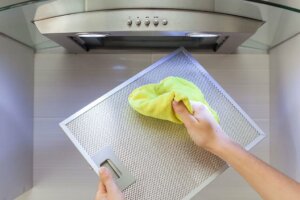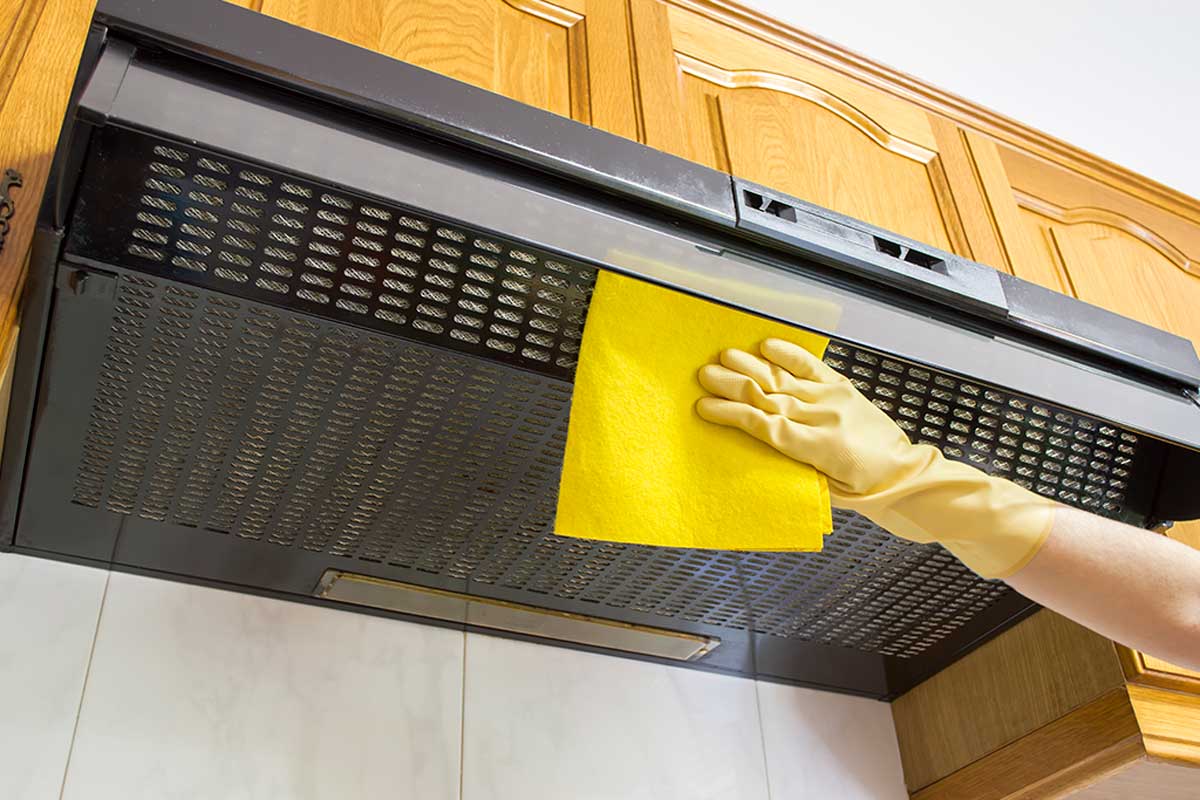Let's Clean The Kitchen Extractor Hood!

Preparing to clean the kitchen extractor hood is a necessary task. Removing the fat that begins to accumulate both on the inside and on the outside is a challenge. However, we’ve got some tricks that’ll make your work easier and will leave the hood as new.
Clean the inside of your kitchen extractor hood
Cleaning the inside of the kitchen extractor hood is much more complex than cleaning other parts. The reason? It’s there where more fat accumulates since the steam that it absorbs from the food carries particles that end up sticking on all sides.
Use degreaser

For this job, the degreaser has been created, to easily dissolve fat. There are different brands and different compounds depending on the surface to be cleaned. Since your hood is likely to be made of stainless steel, use one specialized in cleaning this material. Follow these steps for optimal cleaning:
- Remove the lids and filters from the extractor.
- Once within reach, spray the product on the inside of the hood.
- We almost always skip this step! Wait a few minutes for the product to do its thing and soften the fat.
- Use a soft cloth or sponge to begin removing the grease. You’ll see how this is easily removed.
- If you haven’t cleaned your kitchen extractor hood in a long time, you may need to repeat the process. Wash the cloth before using it again.
Try baking soda

If you have baking soda on hand, don’t waste it or spend extra money on cleaning products, this will serve your purpose. Here’s how you should use it:
- Heat baking soda water in a couple of pots and turn on the extractor when it starts to boil.
- Let the mixture do its work for at least an hour, so the steam penetrates all the internal corners of the hood.
- If the water evaporates too quickly, add more water and more baking soda.
- When you see that the fat begins to fall, remove the pots and turn off the heat.
- To prevent the fat that begins to fall from sticking to the heated elements, before starting, place absorbent paper or aluminum, being very careful not to burn yourself.
- Once the hood is warmer, but not cold, use a damp cloth or sponge with water or white vinegar to finish removing the grease.
Cleaning the outside of the kitchen extractor

Choose a stainless steel degreaser or some white vinegar, whichever you have on hand, and follow these steps:
- Unplug the extractor and spray your chosen product on top.
- Use a soft cloth or sponge to begin removing the grease after a couple of minutes.
- In the case of the digital board or buttons, please don’t spray directly. Do it on the cloth and then clean.
Don’t forget the filters!
Keeping the cooker hood filters clean and clear is very important. As you already removed them to clean the interior, before putting them on, don’t forget to clean them. Here are the instructions:
- Heat a little water, then add some degreaser.
- Transfer this preparation to a container and insert the filters, let them soak for a few minutes.
- Take out piece by piece and wipe each with a cloth to remove the fat.
- More complex areas can be cleaned first with a soft brush.
Remember that in the case of recirculation hoods it’s not necessary to clean the filters. This because your system filters the air it absorbs and then returns it to the kitchen. Being carbon, you must be vigilant and change it for a new one when the time comes.
How often should you clean the kitchen extractor hood?
In the case of the exterior of the kitchen extractor hood, the ideal is to clean it after each use. This will prevent the fat from accumulating and hardening. For the interior, try to do it once a month.
Remember that, beyond aesthetics, the kitchen needs to be clean to avoid the proliferation of bacteria and microorganisms that can pass into the food and affect the health of the family.
Preparing to clean the kitchen extractor hood is a necessary task. Removing the fat that begins to accumulate both on the inside and on the outside is a challenge. However, we’ve got some tricks that’ll make your work easier and will leave the hood as new.
Clean the inside of your kitchen extractor hood
Cleaning the inside of the kitchen extractor hood is much more complex than cleaning other parts. The reason? It’s there where more fat accumulates since the steam that it absorbs from the food carries particles that end up sticking on all sides.
Use degreaser

For this job, the degreaser has been created, to easily dissolve fat. There are different brands and different compounds depending on the surface to be cleaned. Since your hood is likely to be made of stainless steel, use one specialized in cleaning this material. Follow these steps for optimal cleaning:
- Remove the lids and filters from the extractor.
- Once within reach, spray the product on the inside of the hood.
- We almost always skip this step! Wait a few minutes for the product to do its thing and soften the fat.
- Use a soft cloth or sponge to begin removing the grease. You’ll see how this is easily removed.
- If you haven’t cleaned your kitchen extractor hood in a long time, you may need to repeat the process. Wash the cloth before using it again.
Try baking soda

If you have baking soda on hand, don’t waste it or spend extra money on cleaning products, this will serve your purpose. Here’s how you should use it:
- Heat baking soda water in a couple of pots and turn on the extractor when it starts to boil.
- Let the mixture do its work for at least an hour, so the steam penetrates all the internal corners of the hood.
- If the water evaporates too quickly, add more water and more baking soda.
- When you see that the fat begins to fall, remove the pots and turn off the heat.
- To prevent the fat that begins to fall from sticking to the heated elements, before starting, place absorbent paper or aluminum, being very careful not to burn yourself.
- Once the hood is warmer, but not cold, use a damp cloth or sponge with water or white vinegar to finish removing the grease.
Cleaning the outside of the kitchen extractor

Choose a stainless steel degreaser or some white vinegar, whichever you have on hand, and follow these steps:
- Unplug the extractor and spray your chosen product on top.
- Use a soft cloth or sponge to begin removing the grease after a couple of minutes.
- In the case of the digital board or buttons, please don’t spray directly. Do it on the cloth and then clean.
Don’t forget the filters!
Keeping the cooker hood filters clean and clear is very important. As you already removed them to clean the interior, before putting them on, don’t forget to clean them. Here are the instructions:
- Heat a little water, then add some degreaser.
- Transfer this preparation to a container and insert the filters, let them soak for a few minutes.
- Take out piece by piece and wipe each with a cloth to remove the fat.
- More complex areas can be cleaned first with a soft brush.
Remember that in the case of recirculation hoods it’s not necessary to clean the filters. This because your system filters the air it absorbs and then returns it to the kitchen. Being carbon, you must be vigilant and change it for a new one when the time comes.
How often should you clean the kitchen extractor hood?
In the case of the exterior of the kitchen extractor hood, the ideal is to clean it after each use. This will prevent the fat from accumulating and hardening. For the interior, try to do it once a month.
Remember that, beyond aesthetics, the kitchen needs to be clean to avoid the proliferation of bacteria and microorganisms that can pass into the food and affect the health of the family.







